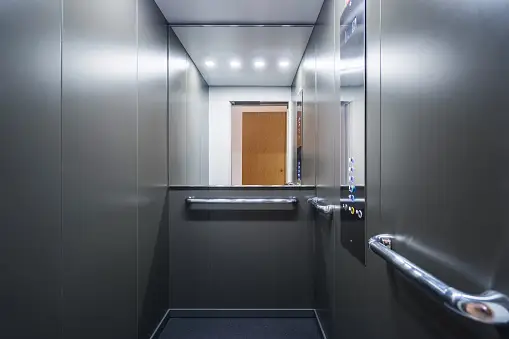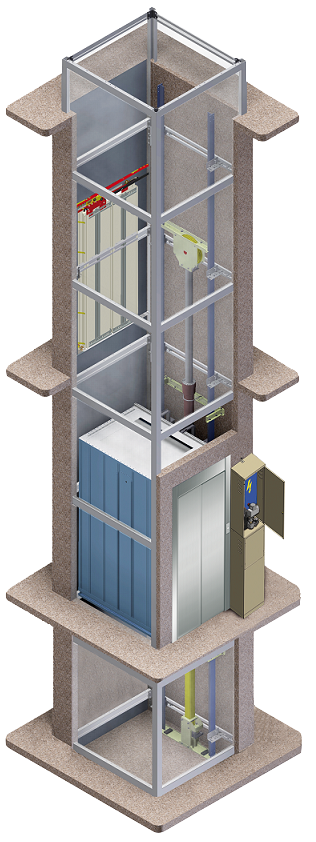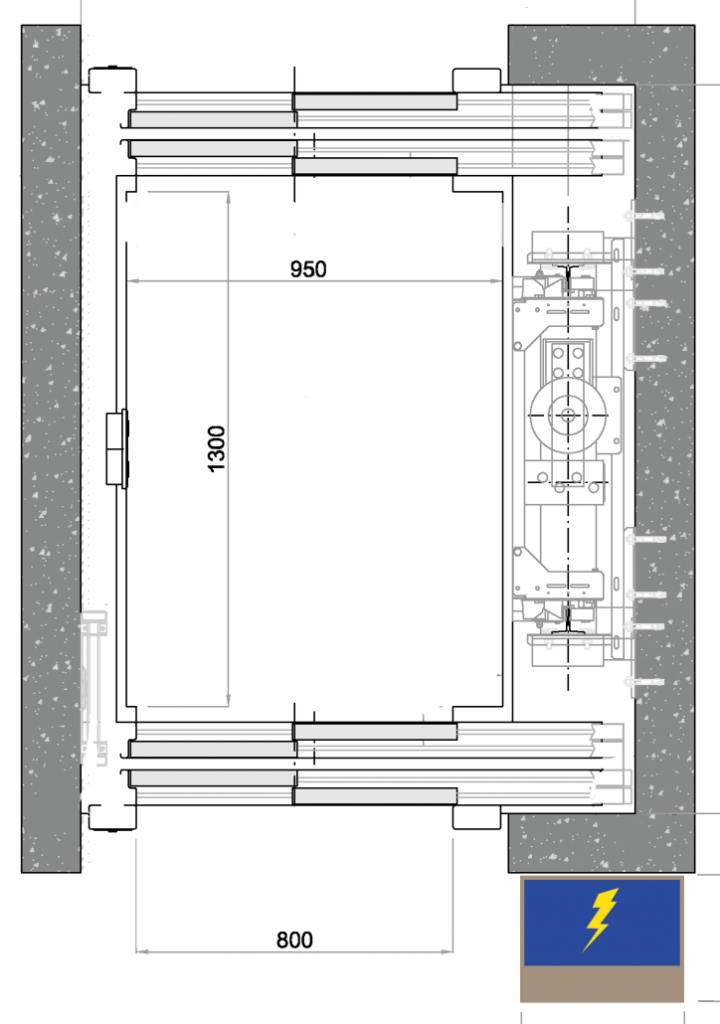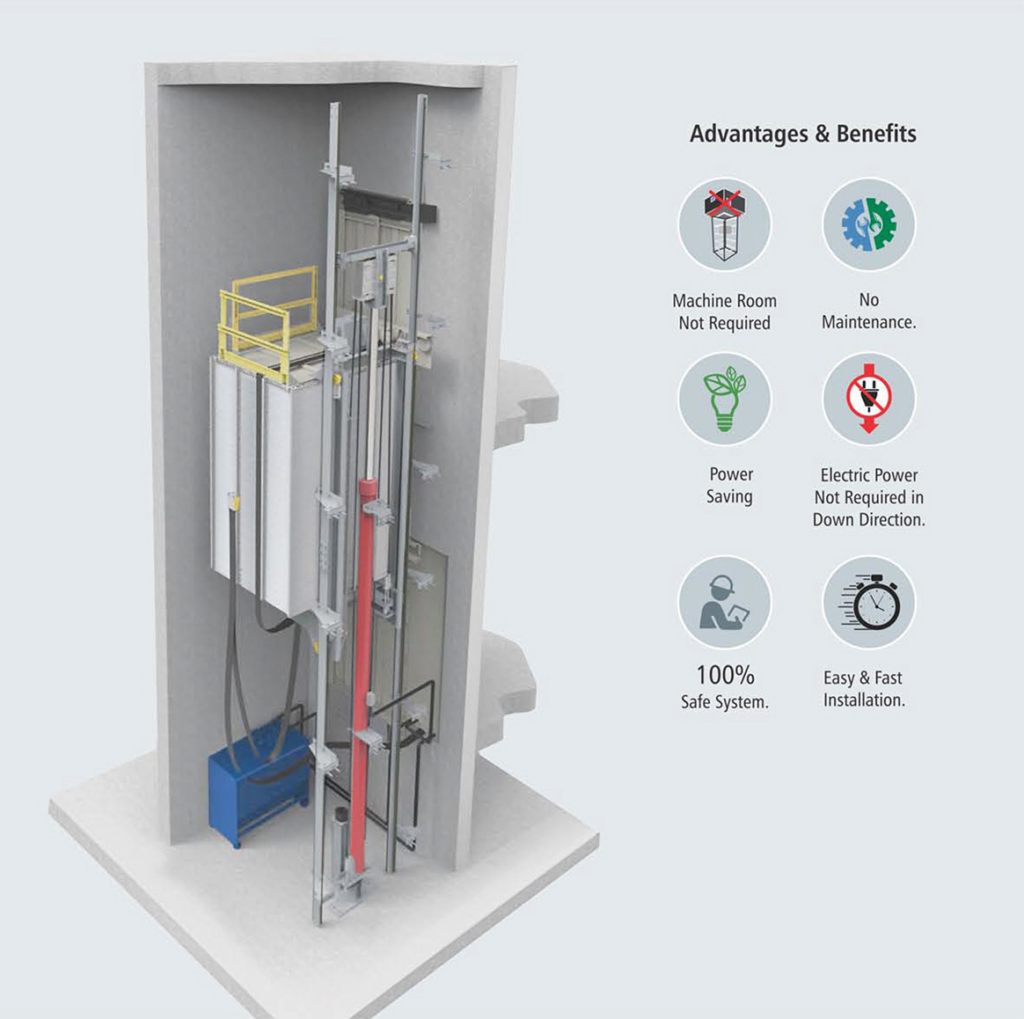
What is a hydraulic lift?
Hydraulic elevators are like the heavy-duty workhorses of the elevator world, designed to handle lots of people going up and down regularly without breaking a sweat. Not only do they provide a super smooth and quiet ride, but they’re also known for being tough cookies, able to handle heavier loads and serve buildings with more floors. In Kenya, if you’re looking for a reliable lift that can efficiently serve up to 6 floors, StarCraft Technologies Limited has got you covered with their top-notch hydraulic lifts. However, if you’re aiming higher than 6 floors, they might recommend checking out traction lifts. So, how do these hydraulic lifts do their magic? Well, they’ve been around for a while, especially in buildings from the latter part of the 20th century. The trick lies in an electric pump that pushes oil through a system to lift the elevator. Picture a piston in a cylinder at the base of the elevator doing the heavy lifting – quite literally. When you press the call button from a higher floor, the hydraulic fluid gets pumped into the cylinder, making the elevator go up. Now, going down is just as smooth. The controller opens a valve, slowly releasing the pressure in the hydraulic tank after a call from a lower floor. It’s like a controlled descent using gravity, which is not just cool but also makes them pretty power-efficient. And here’s a nifty feature – if the power decides to take a break, these elevators won’t. Thanks to a battery backup, they can gracefully lower the elevator during a power outage, all on their own. Talk about being prepared for anything! Hydraulic elevators can serve up to 6 stops or 50′ of travel and are available in a wide variety of cab styles with different configurations. There are several things to keep in mind when planning for this type of elevator:
- Working mechanism and major components of an hydraulic lift
- The elevator and installation
- Equipment layout, design, and machine room
- Cab style and finish details
- Hoistway construction
- Landing doors and types
- Service and maintenance of your elevator

Working mechanism and major components of an hydraulic lift
Hydraulic lifts operate on the principle of Pascal’s law, which states that when pressure is applied to a confined fluid, the pressure is transmitted equally in all directions. This allows hydraulic lifts to lift heavy loads with relatively small amounts of force. The major components of a hydraulic lift and their working mechanism include:
- Hydraulic Pump: The hydraulic pump is the primary component that generates pressure by forcing hydraulic fluid into the system. It may be powered by an electric motor or an internal combustion engine. The pump creates a flow of pressurized hydraulic fluid, which is essential for the lift’s operation.
- Fluid Reservoir: The fluid reservoir stores hydraulic fluid, which is necessary for the operation of the hydraulic system. It ensures that an adequate supply of fluid is available to the pump and other components of the hydraulic lift.
- Hydraulic Fluid: Hydraulic fluid is a specially formulated liquid that is used to transmit power within the hydraulic system. It is non-compressible and serves as a medium for transferring force from one component to another. Hydraulic fluid is selected based on its viscosity, temperature range, and compatibility with system components.
- Hydraulic Cylinders: Hydraulic cylinders are the actuators responsible for lifting or lowering the load. They consist of a cylinder barrel, piston, and rod. When pressurized hydraulic fluid is directed into the cylinder, it pushes against the piston, causing it to move and exert force on the load. The size and stroke length of the cylinder determine the lifting capacity and travel distance of the hydraulic lift.
- Control Valves: Control valves regulate the flow of hydraulic fluid within the system. They direct the fluid to the hydraulic cylinders to initiate lifting or lowering movements. Control valves may be manually operated or automated, depending on the design of the hydraulic lift.
- Check Valves: Check valves prevent the backflow of hydraulic fluid and maintain pressure within the system. They ensure that the load remains lifted even when the hydraulic pump is turned off or when the lift is in a stationary position.
- Pressure Relief Valve: The pressure relief valve is a safety device designed to prevent overloading and excessive pressure buildup within the hydraulic system. It automatically opens when the pressure exceeds a predetermined threshold, allowing excess fluid to escape and relieving pressure on the system components.
- Safety Features: Hydraulic lifts are equipped with various safety features to protect against accidents and ensure the safety of users and property. These may include emergency stop buttons, safety rails, interlocks, and overload protection devices.
The working mechanism of a hydraulic lift involves the following steps:
- The hydraulic pump pressurizes hydraulic fluid and sends it through the hydraulic system.
- The control valves direct the pressurized fluid to the hydraulic cylinders.
- The hydraulic cylinders extend or retract, depending on the direction of fluid flow, thereby lifting or lowering the load.
- The pressure relief valve maintains safe operating pressure within the system and prevents overloading.
- Safety features ensure the safe operation of the hydraulic lift and protect against potential hazards.
Overall, the hydraulic lift’s efficient and reliable operation relies on the coordinated functioning of its major components within the hydraulic system.
The Elevator and Installation
The most popular type of hydraulic home elevator is called a 1:2 roped hydraulic elevator. This means that for every inch the piston moves, the cab moves two inches. This ratio allows for a longer travel range and a shorter cylinder assembly. It’s great for homes with standard 8-foot ceilings because it fits well. Ideally, installers prefer a floor-to-ceiling height of 9 feet 6 inches for the top level, but sometimes, there isn’t enough space for that. Another important thing to notice is the wide distance between the guide rails (DBG). This is crucial for a smooth and stable ride between floors. The guide rails are like the foundation of the elevator system. A wider space reduces side-to-side movement. In the picture, you can see that the rails on the left and right sides are almost touching the shaftway walls. Just like any other product, home elevators are made by different companies with varying levels of quality and design. When choosing a hydraulic elevator, it’s important to look for high-quality components and materials to ensure safety and reliability.

Specs of a typical hydraulic lift (info is based on a GLF MRL model)
| GLF | GLC MRL | ||||||
| Description | With very compact cabinet (W 440 x D 300 x H 2000 mm), containing control panel and dry power unit, designed to be positioned next to a landing door, or near the shaft. Advantages: SAFETY, SIMPLICITY AND ECONOMY IN MAINTENANCE | ||||||
| Drive | Indirect hydraulic 2:1 with side acting piston | ||||||
| MRL | YES | ||||||
| Rated load (kg) | 320 | 350 | 450 | 630 | 900 | ||
| Capacity (passengers) | 4 | 6 | 8 | 12 | |||
| Speed (m/s) | Upward travel | from 0,4 to 0,86 | |||||
| Downward travel | from 0,4 to 1 | ||||||
| Maximum number of stops / services | 12 / 24 | ||||||
| Number / entrance types | 1 – 2 opposite – 2 adjacent – 3 | ||||||
| Max. cabin travel (m) | 19 up to 630 kg – 16 beyond 630 kg | ||||||
| Possibility of reduced pit/headroom | Yes | ||||||
| Minimum headroom (mm) | Standard | 3300 | |||||
| Reduced | 2750 for load up to 630 kg – 2800 for load beyond 630 kg | ||||||
| Reduced special | 2500 | ||||||
| Minimum pit (mm) | 1000 for load up to 630 kg – 1100 for load beyond 630 kg | ||||||
| 450 for load up to 630 kg – 500 for load beyond 630 kg | |||||||
| Shaft type | Reinforced concrete / Brickwork / Metal structure | ||||||
Hydraulic elevator safety features
Hydraulic elevators are some of the safest in the industry. The systems have several features built-in for fail-safe operation. One of the best features of hydraulic systems is the elevators are engineered and designed specifically for each individual installation. Because of this, they will only travel to the maximum total floor-to-floor distance plus 2″-3″ of runby or overtravel (extra buffer space), meaning they can never move more than a few inches past the top landing. The elevators will also include a flow control switch to prevent overspeed in the down direction and a pump-run timer to monitor the travel time between landings. The rated speed for an in-home hydraulic elevator is 40 fpm, traveling 20 feet will take approximately 30 seconds. The cabs are supported with two 3/8” diameter steel cables rated for thousands of pounds. The cables are connected to an instantaneous braking system that is also continuously monitored by a PLC-based controller. Hydraulic elevator control valve and tank enclosed with submersible pump monitoring fluid pressure. The manual lowering valve and gate valve are easily accessible for service.

Advantages of Hydraulic Lifts
A Quiet Ride – Even with a small machine room, our hydraulic elevators deliver a quiet and gentle ride every ascent and descent. Our customers are frequently amazed by how seamless the riding experience is every time.
Low Space and Low Maintenance – Hydraulic lifts don’t require as much overhead space, relying on a piston and pump setup rather than hoisting machinery. And don’t worry about dealing with a complicated-looking system. We offer a comprehensive standard warranty that covers service during the lifetime of your elevator.
Other Additional Benefits
With so many advantages, it’s no surprise that hydraulic elevators are so popular in the home. These systems offer:
- A smooth and comfortable ride
- Commercial-grade functionality inside the home
- High customizability with plenty of upgrades
- A full range of material and accessory options
- Front, side, and rear openings
How to properly service and maintain a hydraulic elevator
Proper service and maintenance of hydraulic elevators are essential to ensure their safe and efficient operation. Regular maintenance helps prevent breakdowns, extends the lifespan of elevator components, and ensures compliance with safety regulations. Here’s a detailed guide on how to properly service and maintain a hydraulic elevator. Hydraulic elevators should have regular lifts maintenance and be checked annually for normal operation.
StarCraft Ltd is committed to providing safe and reliable transportation solutions through its hydraulic elevator servicing and maintenance program. With a team of highly skilled technicians and a dedication to quality service, StarCraft Ltd ensures that hydraulic elevators operate smoothly and efficiently while adhering to strict safety standards. Here’s a detailed overview of how StarCraft Ltd properly services and maintains hydraulic elevators:
- Initial Inspection and Assessment:
Before servicing or maintaining a hydraulic elevator, StarCraft Ltd conducts a thorough initial inspection and assessment. This involves examining the entire elevator system, including the hydraulic cylinders, pump, valves, hydraulic fluid levels, and safety mechanisms. Technicians identify any existing issues, wear and tear, or potential areas of concern.
- Scheduled Maintenance Checks:
StarCraft Ltd follows a proactive approach to maintenance by scheduling regular checks and inspections of hydraulic elevators. These maintenance checks are conducted according to manufacturer recommendations and industry standards. During these checks, technicians inspect and lubricate moving parts, check hydraulic fluid levels, and test safety features such as emergency brakes and door sensors.
- Hydraulic System Maintenance:
The hydraulic system is the heart of a hydraulic elevator, and StarCraft Ltd pays special attention to its maintenance. Technicians inspect hydraulic cylinders for signs of leaks, corrosion, or structural damage. They also check hydraulic fluid levels and monitor the condition of filters and seals. If necessary, technicians perform hydraulic fluid flushes and replace worn-out components to ensure optimal performance.
- Safety Inspections and Testing:
Safety is paramount in elevator maintenance, and StarCraft Ltd prioritizes rigorous safety inspections and testing procedures. Technicians conduct comprehensive safety checks, including testing emergency brakes, door interlocks, overspeed governors, and emergency communication systems. Any safety issues or malfunctions are promptly addressed and resolved to prevent accidents and ensure passenger safety.
- Component Replacement and Upgrades:
Over time, certain elevator components may wear out or become obsolete. StarCraft Ltd regularly evaluates the condition of elevator components and recommends replacement or upgrades as needed. This may include replacing worn-out hydraulic cylinders, valves, pumps, or upgrading control systems to improve performance and efficiency.
- Compliance with Regulations and Standards:
StarCraft Ltd ensures that all hydraulic elevator servicing and maintenance activities comply with relevant regulations, codes, and standards. Technicians stay updated on industry best practices and regulatory requirements to ensure that elevators meet or exceed safety and performance standards.
- 24/7 Emergency Service and Support:
In addition to scheduled maintenance checks, StarCraft Ltd offers 24/7 emergency service and support for hydraulic elevators. Experienced technicians are available round-the-clock to address any unexpected issues, breakdowns, or emergencies promptly. This ensures minimal downtime and disruptions to elevator operations, allowing businesses and building owners to maintain smooth and uninterrupted transportation services.
- Client Communication and Reporting:
StarCraft Ltd believes in transparent communication and provides detailed reports to clients after each maintenance visit. These reports outline the findings of the inspection, maintenance activities performed, any identified issues, and recommendations for further action. Clients are kept informed throughout the maintenance process, allowing them to make informed decisions regarding elevator upkeep and repairs. In conclusion, StarCraft Ltd’s comprehensive approach to hydraulic elevator servicing and maintenance ensures the safe and reliable operation of elevator systems. Through regular inspections, proactive maintenance checks, safety testing, and adherence to industry standards, StarCraft Ltd strives to exceed client expectations and maintain the highest levels of elevator performance and safety.
IF you have read this knowledge article to this point, it is likely that you are considering ordering a lift system for your building or client’s building or simply open to working with us. We are Lifts and Escalators repair Experts in Kenya. We handle elevator and escalator job tasks from procurement to maintenance. If you need further details about our services, call us via +254-712-781-632
Let us Work Together 🙂